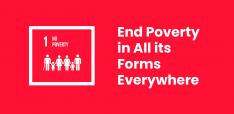The World Bank has a new way to Measure Inequality

As debates over globalisation continue in the global North, the World Bank’s new measure of poverty suggests that there have been a significant number of winners.
As we worked on a new World Bank flagship report that provides the latest and most accurate estimates on trends in global poverty and shared prosperity, it became apparent as to what we wanted for the title - Poverty and Shared Prosperity 2016: Taking on Inequality.
Because in our minds it became clear that inequality is becoming increasingly critical to meeting the World Bank’s goals of ending poverty and sharing prosperity. In fact, we find that tackling inequality will make or break the goal of ending poverty by 2030.
Now, the world has made tremendous progress in reducing global extreme poverty - nearly 1.1 billion have escaped extreme poverty since 1990 - but there are still around 800 million people or one in ten people living on less than $1.90 a day today. This number is still unacceptably high, especially given the low standards of living implied by the international poverty line.
Historically, we know the importance of growth in driving poverty reduction. But current growth rates will not be enough to reach the 2030 goal- and we know that global growth forecasts are grim. Therefore we need to make what growth there is beneficial for the poor. To ensure this, we first need to know how growth has performed for the poor.
This is where shared prosperity comes in.
Boosting shared prosperity, the World Bank’s second goal, means that growth needs to translate into gains for the poorest 40 percent of the population in each country. Tracking this progress is important to ensuring that the poorest in every country are improving their lives and livelihoods.
But since we also want to know more about how the poorest are doing vis a vis the rest of the country, we’ve adopted a new indicator, which we call the Shared Prosperity Premium. This compares the growth of the bottom 40 percent with the average—putting an even stronger inequality lens on our efforts to reach the least well-off everywhere.
We see that between 2008 and 2013 the bottom 40 grew faster than the top 60 in 49 of the 83 countries for which we have quality data. In other words, in six out of ten countries (with data) the poorest 40 benefitted more from growth than the rest of the population. These countries were home to at least two thirds of the world’s population. We say “at least”, because for 25 percent of the world population we don’t have enough data to make a call on this. We thus need more, better, and frequent data.

While this is good news, there is widespread perception that inequality is increasing everywhere.
Through our report, we show that this is, in fact, a perception that does not hold true in many parts of the world in the most recent period. If we look at inequality itself, we see similar patterns to that of shared prosperity at the country level for the same period. Out of a sample of 80 countries, inequality went down in more countries than it increased. For every country in which inequality widened substantially, there were two countries in which inequality narrowed substantially. This pattern represents quite a drastic change after inequality increased in many countries during the 1990s and early 2000s.
Even at the global level, inequality between citizens around the world has decreased over the last 25 years, but remains quite high. This was mostly due to average incomes in some large emerging economies catching up with those in industrialized countries, which has reduced between-country inequality.
So, is this progress in reducing inequality enough to help end poverty by 2030?
Our simulations show that even if the strong growth of the last decade persisted, global extreme poverty will not reach the World Bank’s 3 percent goal by 2030. The slowdown currently projected for global growth doesn’t help either. Nor does it help that the poor are increasingly concentrated in Sub-Saharan Africa where progress in poverty reduction has been slower than in other regions, and that those left living in extreme poverty are going to be the hardest to reach between now and 2030.
In order to reach the goal, therefore, growth will have to benefit the poor more than the average - meaning we need a reduction in inequality, and it needs to be better than what is happening today. It is particularly important to reduce inequality in countries where substantial numbers of poor people live, and where inequality is already high.
All of this begs a few questions: how do we translate this into action? Are there countries that have reduced inequality and poverty without compromising growth, if so, what lessons can we learn? And could we solve extreme poverty tomorrow if we just put the right amount of money toward the problem? In future blogs, we will look to answer some of these questions.
It is important to remember that we have come a long way in the fight to end extreme poverty –recall the progress made since 1990, and the widespread improvements in areas from child survival to school enrollments, life expectancy and maternal mortality. Today, ending poverty is at our fingertips but whether we reach our goal or not depends on deliberate action, smart policy choices, and the commitment of people and governments around the world.
This post first appeared on the World Economic Forum's Agenda blog.


